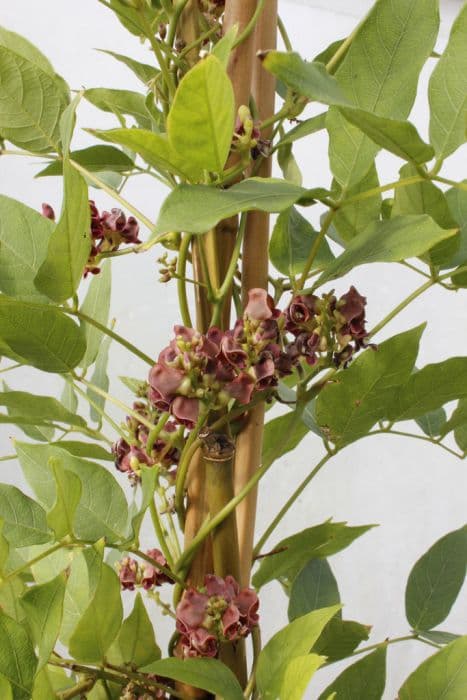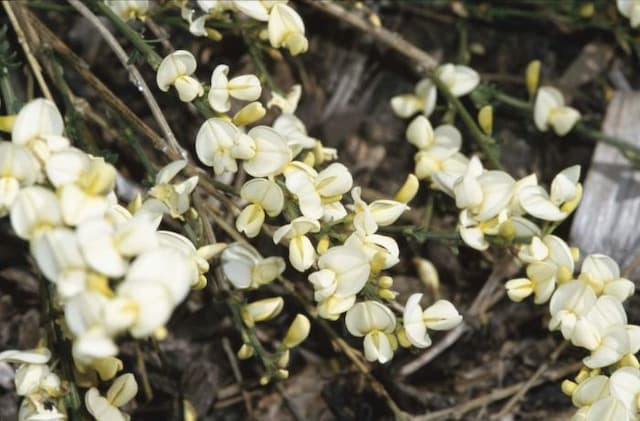Lathyrus odoratus var. nanellus 'Crimson Cherub' (Cherub Series)

ABOUT
The plant known commonly as sweet pea, particularly the 'Crimson Cherub' from the Cherub Series, is a captivating variety with a showy appearance. Its blooms are characterized by a rich crimson color, providing a vibrant and eye-catching display. These flowers typically possess a delightful fragrance, as sweet peas are renowned for their sweet and enticing scent. The petals of 'Crimson Cherub' sweet pea are softly ruffled, which contributes to their lush presence and gives them a romantic and nostalgic flair. Foliar aspects of the sweet pea exhibit bright green leaves, which are slender and pointed, presenting a delicate leaf structure that complements the density of the blossoms. The leaves and stems intertwine, creating a dense green backdrop that allows the crimson flowers to truly pop and draw attention. As a member of the Cherub Series, 'Crimson Cherub' carries the advantageous genetics of this cultivated group, showcasing the ornamental qualities that make sweet peas popular for gardeners and floral enthusiasts. The overall look of the plant is one of vibrant color, sweet perfume, and a graceful form that encapsulates the charm of traditional garden flowers.
About this plant
 Names
NamesSynonyms
Sweet Pea, Everlasting Pea, Perennial Pea, Lathyrus.
Common names
Lathyrus odoratus var. nanellus 'Crimson Cherub'.
 Toxicity
ToxicityTo humans
Sweet pea is generally considered to be toxic when ingested in large quantities. The seeds and other parts of sweet pea contain several toxic compounds, including aminopropionitrile, which can potentially cause a condition known as lathyrism if consumed in substantial amounts. Lathyrism is characterized by symptoms such as muscle weakness, paralysis of the lower limbs, and potentially permanent neurological damage. The toxicity typically occurs after consuming a significant volume of seeds over a prolonged period.
To pets
Sweet pea can be toxic to pets, particularly if they ingest a large amount of the seeds. The seeds contain compounds that can cause lathyrism in animals as well as humans. Symptoms of lathyrism in pets may include lethargy, tremors, convulsions, and potentially paralysis. The severity of the symptoms depends on the amount ingested and can lead to long-term health issues or even death. Pet owners should prevent their animals from consuming the seeds or other parts of the sweet pea plant.
 Characteristics
CharacteristicsLife cycle
Annuals
Foliage type
Deciduous
Color of leaves
Green
Flower color
Crimson
Height
2-3 feet (60-90 cm)
Spread
1-1.5 feet (30-45 cm)
Plant type
Climber
Hardiness zones
2-11
Native area
Mediterranean
Benefits
 General Benefits
General Benefits- Ornamental Value: Lathyrus odoratus (Sweet Pea) has vibrant crimson blooms which add a splash of color to garden spaces.
- Fragrance: The flowers emit a sweet fragrance, contributing to a pleasant sensory garden experience.
- Compact Growth: Being part of the 'Cherub Series', this variety is suitable for smaller gardens or containers due to its compact nature.
- Attracts Pollinators: The flowers attract bees and butterflies, which can help pollinate other plants in the garden.
- Easy to Grow: Sweet Peas are generally easy to cultivate, ideal for novice gardeners or those looking for low-maintenance plants.
- Versatile Planting Options: Can be grown in flower beds, containers, or even as a feature plant along trellises or fences.
- Cut Flower Use: The blooms are long-lasting when cut, making them perfect for bouquets and flower arrangements.
 Medical Properties
Medical PropertiesThis plant is not used for medical purposes.
 Air-purifying Qualities
Air-purifying QualitiesThis plant is not specifically known for air purifying qualities.
 Other Uses
Other Uses- As an educational tool in botany or horticulture classes to study plant growth, flowering patterns, and pollination.
- In art and photography as a live model or subject due to its vibrant colors and aesthetic appeal.
- Used as a natural dye for fabrics, with the flowers providing shades of red and pink.
- In crafting, the dried flowers can be used in potpourri creations, adding scent and color to the mix.
- For culinary presentation, sweet pea flowers can adorn salads and desserts for an edible garnish, although they should be eaten in moderation due to potential toxicity if consumed in large quantities.
- As a theme for events or parties, where sweet pea motifs can be used in decorations, invitations, and even cakes.
- In the creation of eco-friendly confetti, dried sweet pea petals provide a biodegradable option.
- As a source of inspiration for perfumers and fragrance manufacturers to imitate its sweet scent in their products.
- In literature and poetry, sweet pea symbolism can convey messages of departure or goodbyes, as they are often associated with blissful pleasure and farewells.
- In handcrafted paper making, sweet pea petals can be incorporated into the paper for texture and design.
Interesting Facts
 Feng Shui
Feng ShuiSweet pea is not used in Feng Shui practice.
 Zodiac Sign Compitability
Zodiac Sign CompitabilitySweet pea is not used in astrology practice.
 Plant Symbolism
Plant Symbolism- Blissful Pleasure: Sweet pea is often associated with pleasure because of its intoxicating fragrance that brings joy and delight.
- Goodbye: Given when bidding farewell or ending a relationship, it symbolizes the wish for positive memories despite the departure.
- Delicate Pleasures: Reflecting its delicate appearance and scent, sweet pea signifies the enjoyment of life's subtle delights.
- Gratitude: Sweet pea can be used to express thankfulness for a kind action or a pleasurable experience, making it a common gift of appreciation.
- Departure: Similarly to goodbye, it embodies the sentiment of parting ways, often with the hope of future reencounters.
 Water
WaterFor the Sweet Pea 'Crimson Cherub', regular watering is crucial, especially during dry spells, to keep the soil consistently moist but not waterlogged. Aim to water deeply once a week, providing about 1 gallon of water per plant. In hotter weather or if you notice the soil drying out quickly, increase the frequency to every 2 to 3 days. Avoid overhead watering to minimize foliage diseases, and instead, use a soaker hose or drip irrigation to deliver water directly to the base of the plant.
 Light
LightSweet Pea 'Crimson Cherub' thrives in full sun, with at least 6 to 8 hours of direct sunlight each day. Plant them in a spot that receives morning sun and some afternoon shade in hotter climates to protect the blooms from scorching. The ideal location is bright and airy, which encourages healthy growth and vibrant flowers.
 Temperature
TemperatureSweet Pea 'Crimson Cherub' prefers cooler temperatures, with an ideal range between 55-65 degrees Fahrenheit. They can tolerate a minimum temperature of about 50 degrees Fahrenheit at night but should not be exposed to frost. Maximum daytime temperatures should ideally not exceed 70 degrees Fahrenheit for prolonged periods, as higher temperatures can reduce flowering.
 Pruning
PruningPruning Sweet Pea 'Crimson Cherub' involves deadheading spent flowers regularly to encourage continuous blooming. Also, remove any yellowing or diseased leaves to maintain plant health. Prune lightly throughout the blooming season whenever necessary. The best time to prune is in the late afternoon or evening when the plant is less stressed by the sun.
 Cleaning
CleaningAs needed
 Soil
SoilSweet pea 'Crimson Cherub' thrives in a well-draining, fertile loam with a pH of 6.0 to 7.5. A good mix could be one part compost or well-rotted manure, one part garden soil, and one part perlite or sharp sand for improved drainage.
 Repotting
RepottingSweet peas, including 'Crimson Cherub', typically do not require frequent repotting as they are often grown as annuals. They should be planted in their final location where they can climb and have space to flourish.
 Humidity & Misting
Humidity & MistingSweet pea 'Crimson Cherub' prefers moderate humidity conditions and does well in a range where the air isn't too dry, aiming for about 40-60% relative humidity for optimal growth.
 Suitable locations
Suitable locationsIndoor
Provide bright light, cool temps, and support for the vines.
Outdoor
Full sun, cool soil, supports, and fertilize monthly.
Hardiness zone
7-10 USDA
 Life cycle
Life cycleLathyrus odoratus, commonly known as Sweet Pea, begins its life cycle with seed germination, typically in early spring after the last frost when the soil warms. The germinated seeds develop into seedlings with a set of true leaves, and as they mature, the plants grow rapidly, supported by a climbing habit that requires support like trellis or stakes. During the growth phase, Sweet Pea plants develop their iconic fragrant flowers, usually starting in late spring to summer, attracting pollinators and sometimes producing seeds if properly pollinated. After the flowering stage, if seeds are produced, they mature and can be collected late in the summer before the plant starts to wither. As an annual plant, the Sweet Pea then completes its life cycle by dying after seed production, with seeds overwintering to begin the next generation the following spring. The cycle of germination to seed production can vary depending on climate conditions but typically spans a single growing season.
 Propogation
PropogationPropogation time
Spring
Sweet pea, specifically the Lathyrus odoratus var. nanellus 'Crimson Cherub' from the Cherub Series, is most commonly propagated by seed. The best time for sowing sweet pea seeds is typically in spring, as soon as the soil can be worked, but they can also be started indoors 6 to 8 weeks before the last expected frost to get a head start. To maximize germination rates, seeds may be nicked with a file or soaked in water for 24 hours before planting. Sow the seeds about 1 inch deep and space them approximately 2 to 3 inches apart in rich, well-draining soil. Provide support for the climbing vines early on, as sweet peas will begin to vine quickly and need something to climb as they grow.









